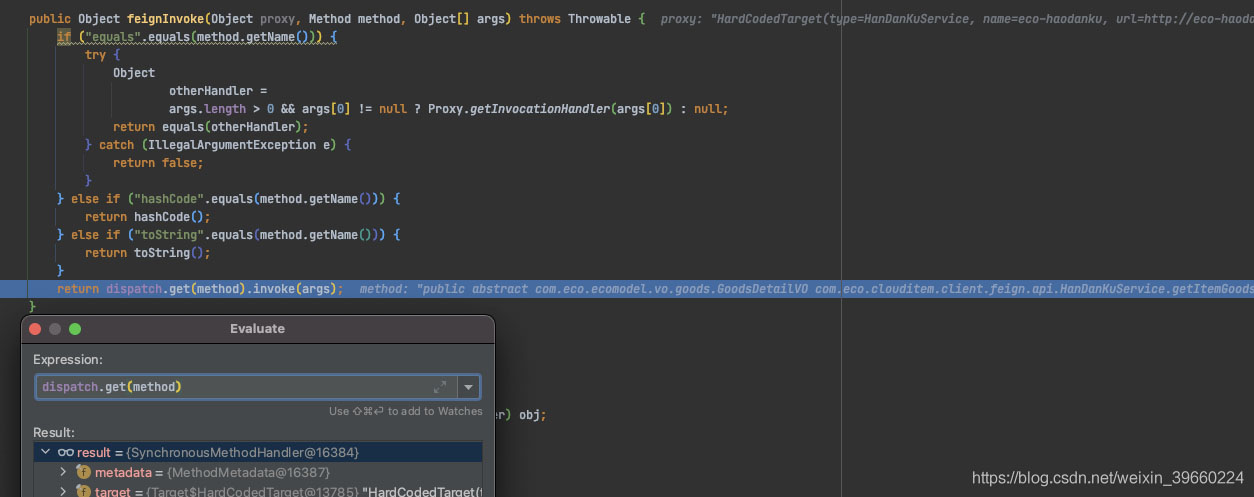需求
最近小编的项目中出现了很多feign 调用出现 Read Time out 的异常,但因为没有集成链路追踪的第三方框架,查不到原因。
所以想到打印请求的ip地址,判断是指定的服务器出现的问题还是所有服务器都有这个问题,但是feign 打印异常日志不会显示目的端地址,这就很难受了没办法只能自己改装下
大致想法
需要改装肯定需要知道feign 具体请求调用的源码,大致需要知道下面几个问题
- feign 集成了ribbon 如何在负载均衡之后获取真实的ip地址
- feign 实际请求 http 源码在哪
- 能否替换 feign http 请求的组件
源码解析
之前小编有两篇文章分析过 feign相关的源码
自定义 feign 调用实现 hystrix 超时、异常熔断
Feign 集成 Hystrix实现不同的调用接口不同的设置
这其中有个关键的源码位置在于 InvocationHandler 的 invoke 方法,在feign 组件中大致有两个类实现了此接口
|
1
2
|
FeignInvocationHandlerHystrixInvocationHandler |
如果 项目中使用了 Hystrix 那么会用到HystrixInvocationHandler那个,否则一般是FeignInvocationHandler(自定义组件的除外)
那么此时只需要在invoke 方法中打个断点就行

此时跟踪到
|
1
|
feign.SynchronousMethodHandler#executeAndDecode |
|
1
2
3
4
5
6
7
8
9
10
11
12
13
14
15
16
|
Object executeAndDecode(RequestTemplate template) throws Throwable { Request request = targetRequest(template); ....... Response response; long start = System.nanoTime(); try { // 真正执行请求 response = client.execute(request, options); response.toBuilder().request(request).build(); } catch (IOException e) { .... throw errorExecuting(request, e); } ..... } |
通过debug就知道这个 client 是
|
1
2
|
LoadBalancerFeignClientorg.springframework.cloud.openfeign.ribbon.LoadBalancerFeignClient#execute |
|
1
2
3
4
5
6
7
8
9
10
11
12
13
14
15
16
17
18
19
20
21
22
23
24
|
public Response execute(Request request, Request.Options options) throws IOException { try { URI asUri = URI.create(request.url()); String clientName = asUri.getHost(); URI uriWithoutHost = cleanUrl(request.url(), clientName); // 封装 ribbon 请求组件 FeignLoadBalancer.RibbonRequest ribbonRequest = new FeignLoadBalancer.RibbonRequest( this.delegate, request, uriWithoutHost); IClientConfig requestConfig = getClientConfig(options, clientName); // 这行是关键 return // 获取 FeignLoadBalancer lbClient(clientName) // 负载之后请求真实的url // com.netflix.client.AbstractLoadBalancerAwareClient#executeWithLoadBalancer(....) .executeWithLoadBalancer(ribbonRequest,requestConfig) .toResponse(); } catch (ClientException e) { .... throw new RuntimeException(e); } } |
|
1
|
com.netflix.client.AbstractLoadBalancerAwareClient#executeWithLoadBalancer(....) |
|
1
2
3
4
5
6
7
8
9
10
11
12
13
14
15
16
17
18
19
20
21
22
23
24
25
26
27
28
29
30
31
32
|
public T executeWithLoadBalancer(final S request, final IClientConfig requestConfig) throws ClientException { LoadBalancerCommand<T> command = buildLoadBalancerCommand(request, requestConfig); try { // 在com.netflix.loadbalancer.reactive.LoadBalancerCommand#submit 中会根据 负载均衡算法之后获取到真实的ip地址 return command.submit( new ServerOperation<T>() { @Override // 传入的server 就是真实的ip public Observable<T> call(Server server) { URI finalUri = reconstructURIWithServer(server, request.getUri()); // 路径替换把原本 http://client-name/xxxx 地址改为 http://127.0.0.1:9090/xxxx S requestForServer = (S) request.replaceUri(finalUri); try { // 请求父类中的 execute 方法,也就是 上面 lbClient(clientName) 返回的 FeignLoadBalancer return Observable.just(AbstractLoadBalancerAwareClient.this.execute(requestForServer, requestConfig)); } catch (Exception e) { return Observable.error(e); } } }) .toBlocking() .single(); } catch (Exception e) { Throwable t = e.getCause(); if (t instanceof ClientException) { throw (ClientException) t; } else { throw new ClientException(e); } } } |
|
1
|
org.springframework.cloud.openfeign.ribbon.FeignLoadBalancer#execute |
|
1
2
3
4
5
6
7
8
9
10
11
|
@Override public RibbonResponse execute(RibbonRequest request, IClientConfig configOverride) throws IOException { Request.Options options; ..... // 这里的 request 就是 `org.springframework.cloud.openfeign.ribbon.LoadBalancerFeignClient#execute` // 封装的FeignLoadBalancer.RibbonRequest // request.client() 返回就是 feign.Client.Default Response response = request.client().execute(request.toRequest(), options); return new RibbonResponse(request.getUri(), response); } |
|
1
|
feign.Client.Default#execute |
|
1
2
3
4
5
|
@Override public Response execute(Request request, Options options) throws IOException { HttpURLConnection connection = convertAndSend(request, options); return convertResponse(connection).toBuilder().request(request).build(); } |
这里的request 中 url 就是真实的url资源路径了
现在屡屡逻辑
|
1
|
org.springframework.cloud.openfeign.ribbon.LoadBalancerFeignClient和feign.Client.Default |
都实现了 feign.Client 接口,但是 LoadBalancerFeignClient 实际上调用的还是 feign.Client.Default,无非做了自己处理(负载),有些类似于静态代理
那么上面的问题就只剩下能否替换的问题了
|
1
2
3
4
5
6
7
8
9
10
|
@Configurationclass DefaultFeignLoadBalancedConfiguration { @Bean @ConditionalOnMissingBean public Client feignClient(CachingSpringLoadBalancerFactory cachingFactory, SpringClientFactory clientFactory) { return new LoadBalancerFeignClient(new Client.Default(null, null), cachingFactory, clientFactory); }} |
这就不需要我来过多解释了,我们只需要自定义一个 LoadBalancerFeignClient 或者 实现Client的类就行 然后注入就行
实现代码
我选择的是 自定义实现一个 Client,去继承 feign.Client.Default
|
1
2
3
4
5
6
7
8
9
10
11
12
13
14
15
16
17
|
@Slf4jpublic class InFeignClient extends Client.Default { /** */ public InFeignClient(SSLSocketFactory sslContextFactory, HostnameVerifier hostnameVerifier) { super(sslContextFactory, hostnameVerifier); } @Override public Response execute(Request request, Request.Options options) throws IOException { try { return super.execute(request, options); } catch (IOException e) { log.warn(" 请求 {} 异常 ======> {}", request.url(), e.getMessage()); throw e; } }} |
然后将这个类替换
|
1
2
3
4
5
6
7
8
9
10
11
12
|
@Componentpublic class RestConfig { public CachingSpringLoadBalancerFactory cachingLBClientFactory( SpringClientFactory factory) { return new CachingSpringLoadBalancerFactory(factory); } @Bean public Client feignClient(SpringClientFactory clientFactory) { CachingSpringLoadBalancerFactory bean = cachingLBClientFactory(clientFactory); return new LoadBalancerFeignClient(new InFeignClient(null, null), bean, clientFactory); } } |
原文链接:https://blog.csdn.net/weixin_39660224/article/details/115397061















